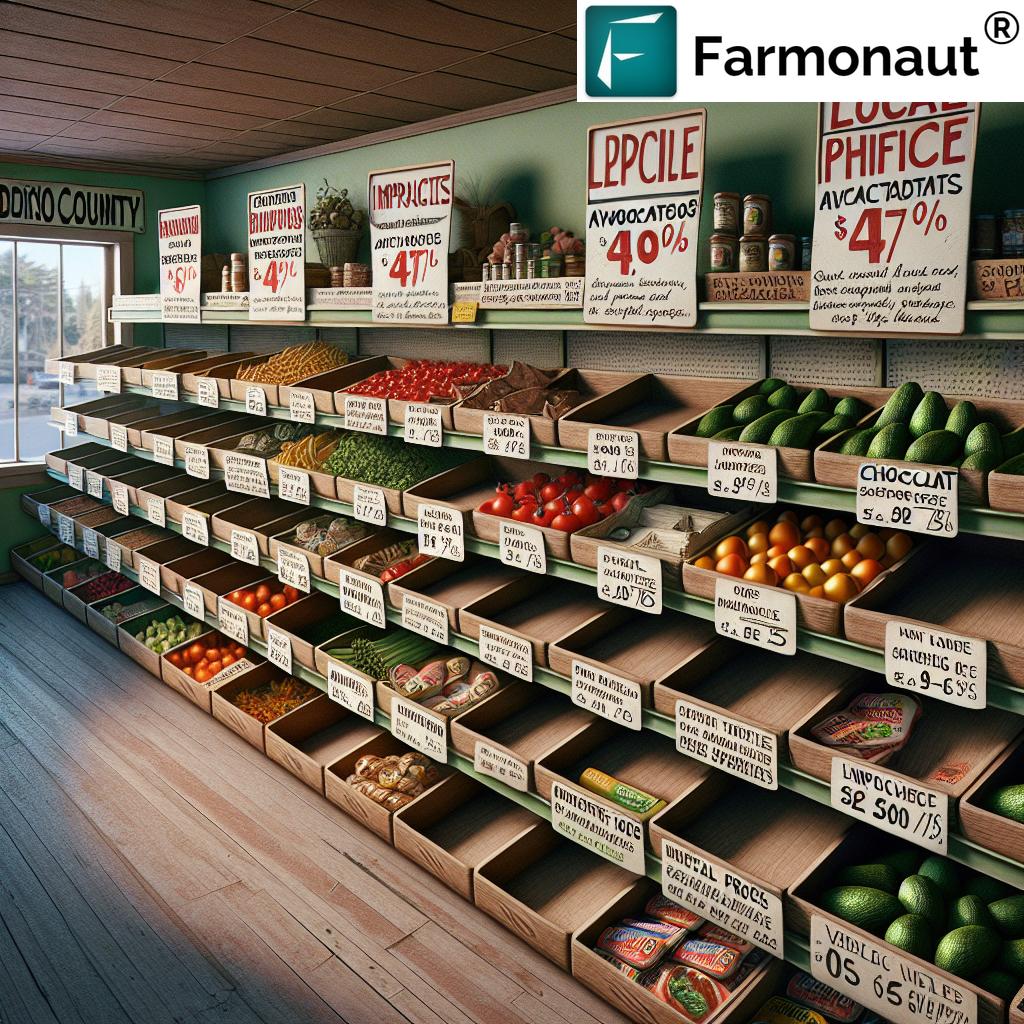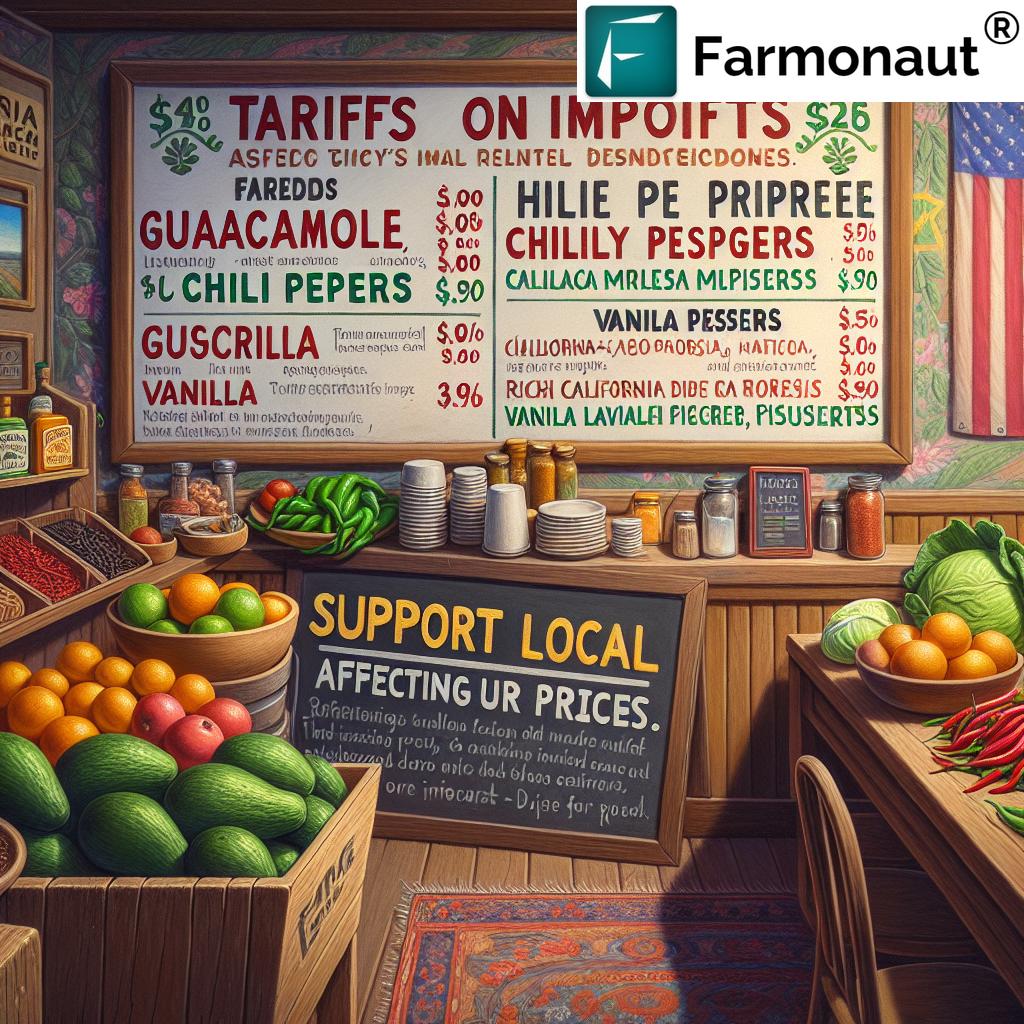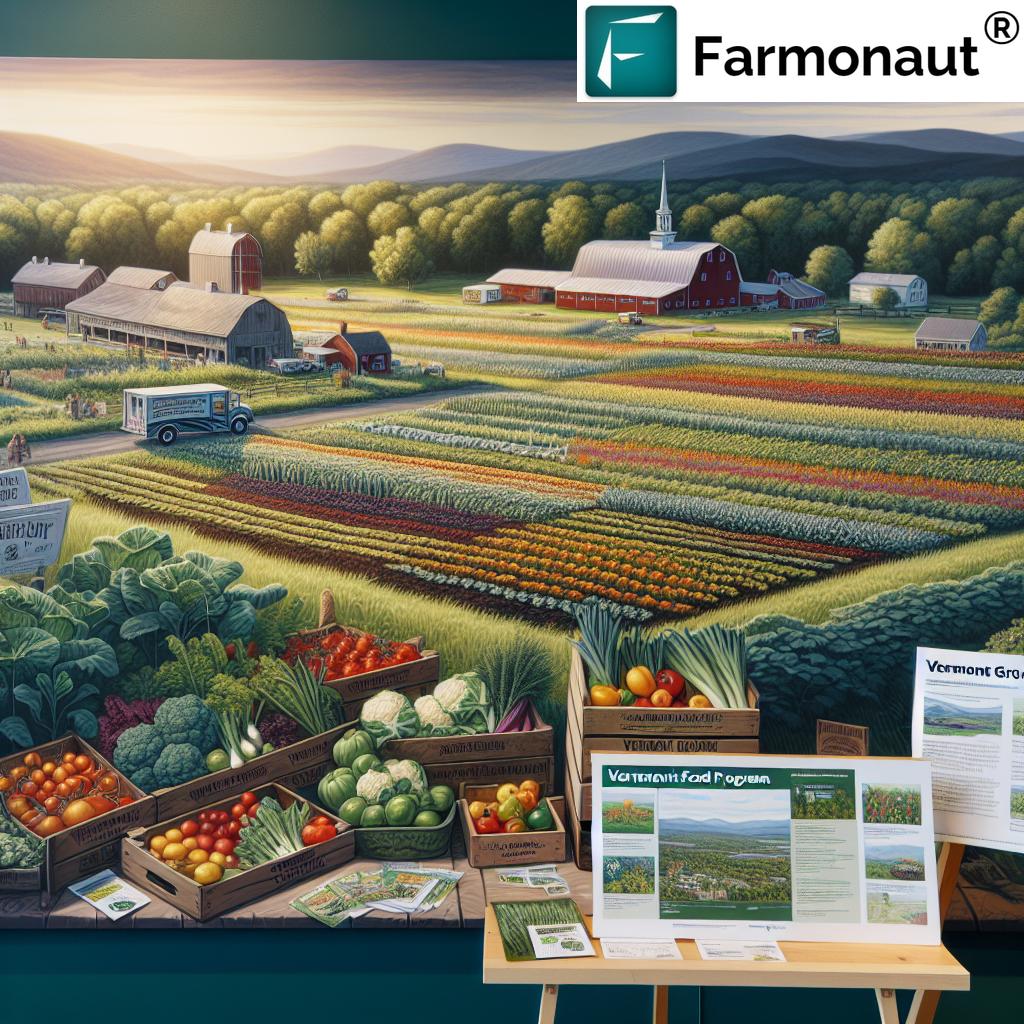Tariffs Impact on Mendocino: 7 Powerful Ways Local Shops Are Hit
“Mendocino restaurants saw food costs rise by up to 15% after recent tariffs.”
Table of Contents
- Introduction: The Tariffs Wave and Our Mendocino Reality
- Understanding Tariffs: What Are We Paying For?
- 7 Powerful Ways Tariffs Impact Mendocino Local Businesses
- 1. Food Ingredient Cost Surge
- 2. Supply Chain Disruptions in California
- 3. Restaurant Menu Price Increases from Import Tariffs
- 4. Decreasing Customer Foot Traffic and Disposable Income
- 5. Squeezing Staff Wages and Employment Stability
- 6. Inventory Shortages & Stocking Challenges
- 7. Business Closures and Long-term Economic Concerns
- Spotlight: Cost of Compostable Packaging
- Local Produce vs Imported Goods: Navigating Increased Costs
- Modern Solutions: Farmonaut Technology for Mendocino’s Farmers
- Supporting Local Restaurants & Shops: What We Can Do
- Tariff Impact Comparison Table
- Frequently Asked Questions: Tariffs & Mendocino’s Small Business Economy
- Conclusion: Building Resilience Together
Introduction: The Tariffs Wave and Our Mendocino Reality
The reality of tariffs is no longer an abstract, national issue: it’s right here on the doorstep of our favorite Mendocino County cafes, stores, and local restaurants. With the Trump administration’s baseline tariffs of 145% on all Chinese imports effective early April, and looming 10% blanket tariffs on the table, owners and shoppers alike feel the pinch.
We see the effects in our lunch bills, at the produce aisle, and in the nervous conversations of small business owners. One Ukiah store owner shared in a Facebook group that even focusing on U.S. made goods is not a cushion—because supply chain expectations, vendor increases, and resulting cost hikes ripple through every layer of the economy. Everyday Mendocino County business decisions, from the price of guacamole at your go-to Mexican place (think avocados, chili peppers, tomatoes from Mexico, onions from China!), to the type of take-out cups, are affected.
Families are paying more for food. Small shops and restaurants are gritting their teeth through price hikes on imports, managing inventory gaps, and bracing for a summer with fewer tourists. Let’s explore the full scale of how tariffs impact local businesses—and what actionable steps we, as a community, can take.
Understanding Tariffs: What Are We Paying For?
Tariffs are taxes or duties placed on goods imported from another country. The stated purpose is often to protect U.S. industries or serve as leverage in trade disputes, but in practice, the price increases from import tariffs are passed onto businesses and, inevitably, consumers.
In 2025, Mendocino’s local shops, restaurants, and food businesses have all felt the brunt of tariffs impact on local businesses. Ingredients, supplies—even so-called “eco-friendly” compostable cups and packages (mostly made in China, per the Rohnert Park World Centric brand)—are seeing increased costs of at least 25%. When we dine, shop, and celebrate in our county, we are—directly and indirectly—paying more.
Let’s break down the seven main ways these new tariffs are driving food price hikes in 2025 across the Mendocino County small business economy.
“Over 60% of local shops in Mendocino reported supply chain delays due to new tariffs.”
7 Powerful Ways Tariffs Impact Mendocino Local Businesses
1. Food Ingredient Cost Surge
Perhaps the most immediate and visible symptom of tariffs impact on local businesses is the spike in staple food and ingredient prices. Take your next plate of guacamole: avocados (from Mexico), chili peppers, tomatoes, onions (often from China)—all are core components in many Mexican restaurants. After the tariff increases, the cost of imports has jumped, sometimes by double digits.
- Avocados & Fresh Produce: Heavily dependent on cross-border supply. The U.S. imports the majority of its avocados and sweet onion supply; tariffs mean higher wholesale and retail costs.
- Chocolate, Coffee, Vanilla, Eggs: Sourced globally. As prices increase for these staple food imports, Mendocino restaurants and bakeries are forced to either absorb losses or adjust prices.
- Beverage Staples: For instance, coffee enthusiasts in Fort Bragg shared how their distributor’s wholesale price per pound of coffee shot up $1.20, resulting in a noticeable uptick for each cup sold—even before retail markup.
Every menu, every meal, every food-centered experience is being shaped by this new economic landscape.
2. Supply Chain Disruptions in California
Mendocino county’s shops don’t just feel the punch at the point of purchase; there are supply chain disruptions every step along the way. Increased customs duties lead to administrative bottlenecks, shipping delays, and uncertainty on what prices will look like next month.
- Vendor Price Hikes: As one Ukiah cooking store owner posted, “Our vendors have already increased pricing and cited tariffs as the main reason—more increases are likely coming.”
- Inventory Uncertainty: For business owners in Mendocino county, volatility makes planning (especially for seasonal demand and perishables) a risky proposition.
- Ripple Effects: A 60% majority of local shops reported supply chain delays rooted in new tariffs.
A delay on a shipment of takeout containers can cascade into lost sales, reduced menu offerings, and heavy losses. For restaurant owners who depend on speed and reliability, it can be make or break.
3. Restaurant Menu Price Increases from Import Tariffs
The increased cost of imported food and packaging doesn’t just disappear; it’s reflected in your check at local restaurants. Many have been forced into tough choices: raise prices, shrink portions, or strip down menu variety.
- Bistro Owners: Business from locals and out-of-county visitors is noticeably down, according to multiple restaurant shared reports in regional Facebook groups.
- Event & Wedding Caterers: With food prices up—sometimes 15% or more—food price hikes 2025 have pushed wedding clients to cut back guest lists and menu add-ons. As one local caterer put it, “Disposable income is evaporating at the same time our costs are spiking.”
These menu shifts are a direct demonstration of how tariffs affect restaurant prices and the wider Mendocino County small business economy.
For diners, this means higher bills and fewer affordable options. For restaurant owners, it’s a daily balancing act between staying solvent and staying competitive.
Farmonaut offers API access for developers and organizations seeking to embed advanced, satellite-powered insights into existing agricultural management platforms or supply chain tools, streamlining everything from crop health tracking to weather analytics.
4. Decreasing Customer Foot Traffic and Disposable Income
Economic pressure from tariffs doesn’t end at the business door; it affects all of us as customers, too. When the price of essentials climbs, families reprioritize spending, vacations, and nights out.
- Tourism: Local restaurant owners note a sharp decrease in out-of-county visitors and international travelers. This hit is particularly worrisome as Mendocino relies heavily on seasonal tourism boosts.
- Event Spending: With increased food prices and travel costs up, events and weddings—the bread and butter of many caterers—see reduced guest counts and more scaled-back plans.
5. Squeezing Staff Wages and Employment Stability
As costs climb and customer flow shrinks, Mendocino businesses are confronted with shrinking margins. This inevitably impacts the stability of hourly wages, scheduled shifts, and even job security for local workers.
- Back-of-house staff, servers, support workers—the core of our restaurant and retail experience—are the most vulnerable, often seeing reduced hours or slower wage growth.
- Labor Market Ripple: Small businesses—especially in food and hospitality—are disproportionately affected, as any increased cost (e.g., for imported goods, packaging, or ingredients) is harder to absorb.
As customers, supporting local restaurants and tipping generously have never been more important for the well-being of our community.
6. Inventory Shortages & Stocking Challenges
Unpredictable tariffs and customs bottlenecks are leading to product shortages and empty shelves at locally owned shops. Retailers can’t always maintain the stock customers expect, especially for imported specialty foods and unique cookware.
- Store owners in Ukiah have noted more erratic inventory cycles, sometimes missing key products for weeks due to supply chain hiccups.
- Perishables & Imports: Higher tariffs mean it’s not always cost-effective to import goods that could sit unsold when the public cuts back on spending.
7. Business Closures and Long-term Economic Concerns
Taken together, these factors create an environment in which more local shops face the risk of temporary or permanent closure. As one store owner in the region shared, “We don’t know if we will even have as busy of a summer if travelers don’t come. It’s scary.”
- Closures: Even a temporary downturn can be catastrophic for small, independent businesses trying to make rent and payroll.
- Long-term Local Economy: The Mendocino County small business economy is only as strong as the resilience of its businesses—and the spending power of its community.
While producers focusing on hyper-local supply, like a Covelo rancher raising lamb, goat, or pork, may be less exposed to international tariff policies, most of Mendocino county’s shops, cafes, and restaurants are deeply connected to these global supply chains.
Tariff Impact Comparison Table
| Aspect | Estimated Change (%) | Short-Term Effect | Long-Term Effect |
|---|---|---|---|
| Food Ingredient Costs | +10% to +20% | Immediate hikes in menu and grocery prices | Demand for more local sourcing, menu changes |
| Supply Chain Delays | +7% to +15% | Stock outages, unpredictable deliveries | Potential permanent vendor loss, altered supply networks |
| Restaurant Menu Prices | +8% to +16% | Higher bills for diners, smaller menu selection | Sustained upward pressure; possible customer loss |
| Customer Foot Traffic | -5% to -12% | Fewer shoppers/diners, especially tourists | Seasonal downturns; fragile economic recovery |
| Staff Wages/Employment | -3% to -8% | Reduced hours, hiring freezes, lower morale | Talent drain, less job stability in sector |
| Inventory Availability | -6% to -14% | More frequent product shortages, substitutions | Permanent product loss or shift to alternative goods |
| Business Closures | +2% to +7% | Increase in shop and restaurant closures | Bleak economic impact, loss of community identity |
Spotlight: Cost of Compostable Packaging
The push towards sustainability has encouraged Mendocino restaurants and shops to switch to compostable cups and packages—great for the environment, but now a major cost challenge due to tariffs. The widely used World Centric brand, produced in China but distributed through Rohnert Park, announced a price jump of 25% starting April 1st.
- Why the Increase? Tariffs on Chinese imports, shipping cost inflation, and COVID-19-era supply chain scars combined to drive up prices.
- Local Dilemmas: Shop and restaurant owners have to decide: pass on the cost, raise menu prices, or switch to less eco-friendly alternatives.
Eco-minded diners can help by being understanding—these hikes are largely out of business owners’ hands.
Local Produce vs Imported Goods: Navigating Increased Costs
There’s never been a better time to support local—by buying from Mendocino farmers, shopping at locally owned shops, and favoring local produce over imported goods.
- Local produce helps buffer against volatile international prices. Regional CSAs—Mendo Lake Food Hub, for example—deliver weekly, farm-fresh produce straight to your door, directly benefiting area farmers.
- Farmers’ markets and local co-ops allow us to access seasonal food grown here, not shipped from abroad.
- Local gifts and cookware: When picking up gifts or kitchenware, try the Mendocino county stores and boutiques first to keep dollars circulating in our own economy.
While not every staple ingredient can be sourced locally—think coffee, chocolate, vanilla, or certain specialty spices—the more we choose Mendocino products, the less vulnerable we are to global price swings.
For larger agricultural operations, advanced technology like Farmonaut can make a critical difference. By providing real-time crop health monitoring using satellite data, local farmers can optimize yield, cut costs, and run more sustainable operations even when the outside world feels unpredictable. See details below.
Modern Solutions: Farmonaut Technology for Mendocino’s Farmers
With Mendocino’s small businesses and agriculture increasingly exposed to international shocks, precision agriculture is no longer just a buzzword — it’s a necessity for resilience. Farmonaut is a pioneering agricultural technology company equipping regional farmers with powerful, affordable tools, accessible right from any device.
- Satellite-Based Crop Monitoring: Using multispectral imagery, farmers can monitor crop health, soil moisture, and disease risk in real time—empowering timely, data-driven decisions.
- AI Advisory (Jeevn): Personalized, real-time guidance tailored to your farm’s satellite data, boosting productivity, resource efficiency, and sustainability.
- Blockchain Traceability: Enhance transparency in food supply chains, ensuring the authenticity and traceability of local produce for consumers and reducing risks of fraud.
- Fleet & Resource Management: Optimize the movement and usage of agricultural vehicles and equipment for cost savings and accountability. Learn more about these benefits for scaling farms here.
- Carbon Footprinting: Track and reduce the environmental impact of your operation with real-time emission data for regulatory compliance and long-term sustainability.
- Crop Loan & Insurance: Let satellite data simplify access to crop loans and help reduce fraud with transparent insurance verification.
Farmonaut’s subscription model is flexible for individuals, cooperatives, and agribusinesses. Large-scale farm management features are also available, making these insights accessible whether you farm a single vineyard or coordinate multiple operations across the region.
Supporting Local Restaurants & Shops: What We Can Do
What’s the positive takeaway? While international policies and tariffs often seem far beyond our control, we still carry the power to build economic resilience in Mendocino county:
- Dine Locally: Eat out at your favorite restaurants at least once a week if possible. Tip generously—a few extra dollars mean a lot to the servers and staff weathering economic headwinds.
- Join a CSA: Support farmers through community-supported agriculture, like the Mendo Lake Food Hub, for reliable fresh produce while keeping money circulating locally.
- Choose Local Shops: Make the conscious choice to buy groceries, cookware, and gifts from locally owned shops and markets, supporting the diversity and character of downtown Mendocino and Ukiah.
-
Farmers’ Markets: Visit weekly market stalls for hard-to-find vegetables,
seafood from local fishermen, or specialty goods. - Social Sharing: Spread the word! Share your positive dining and shopping experiences on Yelp, Google, or Facebook. Positive reviews help local businesses maintain visibility and attract more customers.
Together, these steps are the antidote to a challenging climate—keeping our county economy thriving amid tough times.
Frequently Asked Questions: Tariffs & Mendocino’s Small Business Economy
What are tariffs and how do they affect Mendocino local businesses?
Tariffs are taxes imposed on imported goods from other countries. Mendocino’s small businesses, restaurants, and shops are directly impacted as these tariffs cause price increases from import tariffs on ingredients, supplies, and products. Businesses must then decide to pass these increases onto customers or absorb the loss, often leading to menu changes, higher prices, and even job cuts.
Which products are most affected by recent tariffs?
Major items include avocados, chili peppers, tomatoes, onions, coffee, chocolate, vanilla, eggs, and imported packaging. Eco-friendly compostable cups and packages (often sourced from China) have seen significant price hikes.
How are Mendocino restaurants coping with food price hikes in 2025?
Many are raising menu prices, reducing portion sizes, streamlining offerings, or highlighting local alternatives. However, with shrinking disposable income among locals and fewer tourists, these changes can threaten business stability.
Is shopping at locally owned shops really better during tariff increases?
Yes. Shopping at locally owned shops keeps money within the Mendocino community, supporting jobs and businesses that don’t depend as heavily on imported goods. Choosing local also reduces exposure to international price surges.
How does the cost of compostable packaging affect restaurant prices?
With tariffs on Chinese imports, compostable packaging like World Centric’s products rose at least 25% recently. This pushes restaurants to either raise prices, switch packaging options, or swallow smaller margins—all impacting the customer experience.
How can technology help local farmers and shops adapt?
Platforms like Farmonaut provide satellite-based crop monitoring, AI advisory, resource management, and traceability, enabling smarter decisions, optimized yields, and transparency in food production—even when global costs fluctuate. Learn more about large-scale farm management solutions here.
Where can I find more information or get started with Farmonaut?
Farmonaut is accessible via Android, iOS, web app, and API. For developers, check out the API developer documentation.
Conclusion: Building Resilience Together
While external geopolitical shifts are beyond our immediate influence, our collective choices matter. Each meal shared at a local restaurant, every basket of produce from a Mendocino farmer, every purchase at an independently owned shop fortifies our small business economy against the winds of uncertainty.
Precision agriculture platforms like Farmonaut offer area farmers, co-ops, and even governing institutions the tools to minimize costs and maximize sustainability in a climate of unpredictability. But the heart of Mendocino’s resilience will always be in its people: our willingness to invest in each other, share knowledge, and keep our county vibrant no matter what the global economy throws at us.
Now is the time—to support, shop, and dine local; to tip generously; to share openly; and, when possible, to embrace innovative solutions that secure Mendocino’s future for generations to come.
Let’s keep Mendocino strong—one local shop, restaurant, and farm at a time.






















